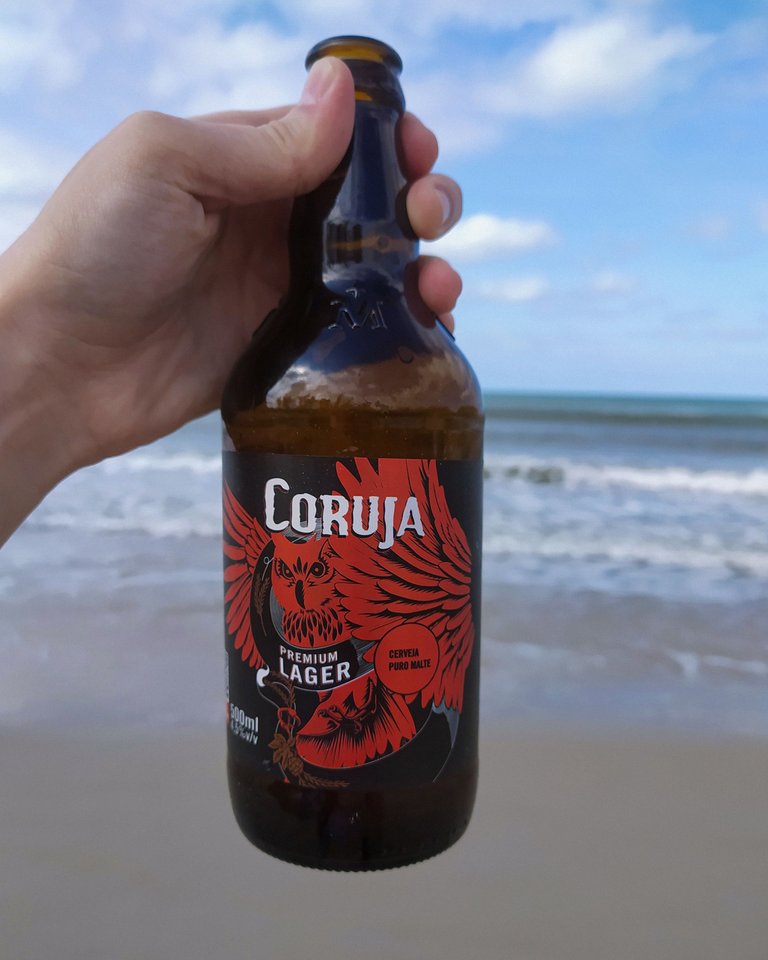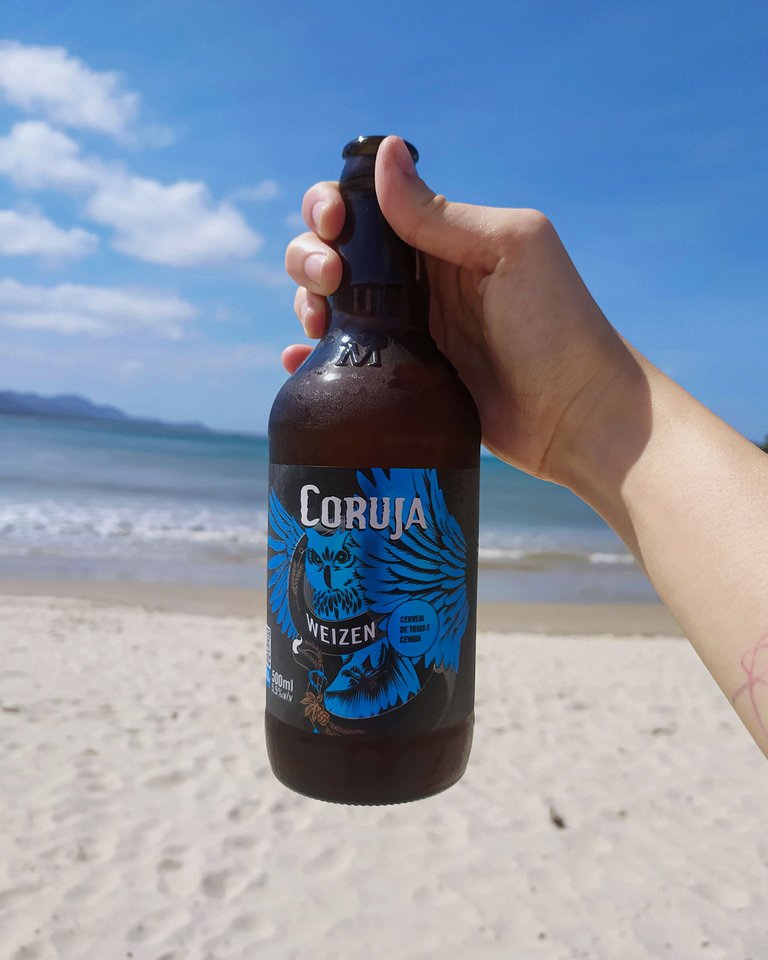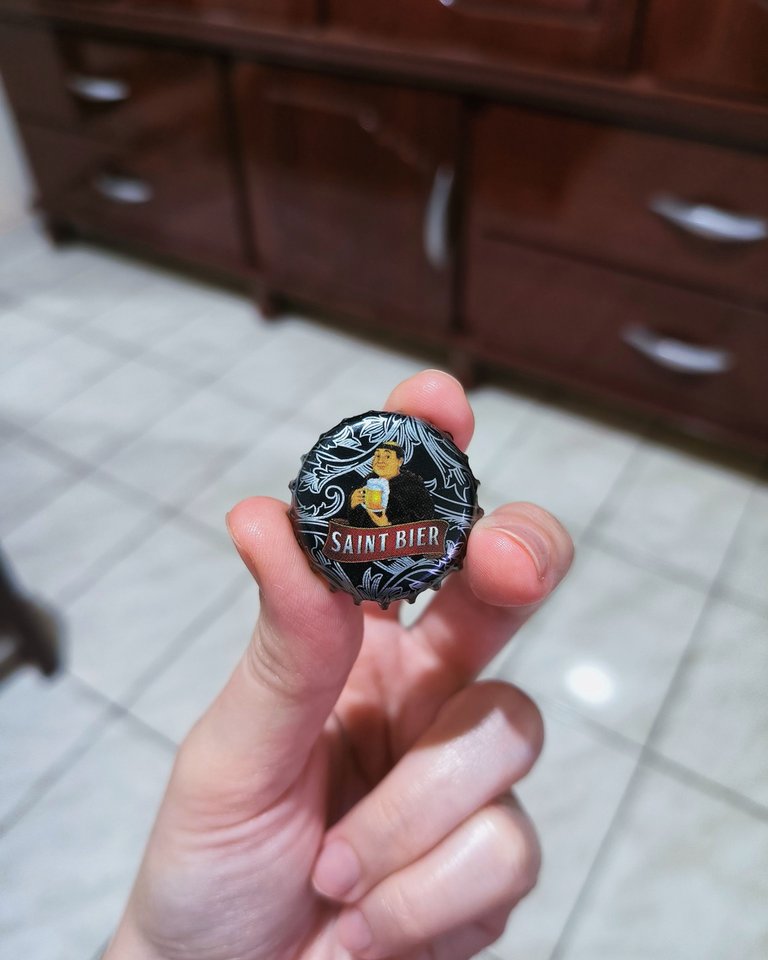Hey, y'all! How are you guys doing lately? I hope everyone is doing well.
It's been quite a while since I went to "Florianópolis", the capital city of Santa Catarina, a state in the Southern region of Brazil. I've already been there several times but surely I never get tired of going to the Ilha da Magia (Island of the Magic, in free translation), as we refer to it here due to its location. As I stated in previous posts, Santa Catarina state stands out when it comes to craft beer production, as it has the highest number of breweries per inhabitant, so, I guess you guys know now why I love going to Floripa, heh.
Floripa is a shortened, casual way to call Florianópolis city.
Among countless accommodation options close to some beach, me and my friends chose to stay in a true hidden gem located in the Eastern edge of the island, which I had no clue it was so beautiful. It's called "Barra da Lagoa", it's a charming neighborhood which was once a fishing village. The place is simple yet complete because it offers everything tourists need.
Barra da Lagoa Beach is a spectacle on its own. On its left side there's good waves and is popular among surfers, while its right side is perfect for those who prefer to just cool off due to the calm water, natural pool-like sea, because it's closer to the pier.
Versión en español
¡Hola mamis y papis! ¿Qué tal lo llevan últimamente? Espero que todo el mundo esté bien.
Hace bastante tiempo que no voy a "Florianópolis", la capital de Santa Catarina, un estado de la región sur de Brasil. Ya estuve allí varias veces, pero seguro que nunca me canso de ir a la Ilha da Magia (Isla de la Magia, en traducción libre), como nos referimos a ella aquí debido a su ubicación. Como dije en posts anteriores, el estado de Santa Catarina se destaca en lo que se refiere a la producción de cerveza artesanal, por tener el mayor número de cervecerías por habitante, así que, supongo que ahora ya saben por qué me encanta ir a Floripa, jeje.
Floripa es una forma abreviada e informal de llamar a la ciudad de Florianópolis.
Entre varias opciones de alojamiento cerca de alguna playa, mis amigos y yo optamos por alojarnos en una verdadera joya escondida, situada en el extremo Este de la isla, de la que no tenía ni idea de que fuera tan bonita. Se llama "Barra da Lagoa", es un barrio encantador que antes era un pueblo de pescadores. El lugar es sencillo pero completo porque ofrece todo lo que los turistas necesitan.
La playa de Barra da Lagoa es un espectáculo por sí sola. En su lado izquierdo hay buenas olas y es popular entre los surfistas, mientras que su lado derecho es perfecto para aquellos que prefieren simplemente refrescarse debido a las aguas tranquilas, el mar en forma de piscina natural, porque está más cerca del muelle.
![floripa[1].jpg](https://images.hive.blog/768x0/https://files.peakd.com/file/peakd-hive/zombialien/Ep1XSm6qfgZnsi98P9Vp5ntGUKBHNo46ud7cztca73o4sLkkjAL2y2uZNhyfMUyvESK.jpg)
The calm sea near the pier and a lighthouse at its end
Not everything is a bed of roses though. Floripa does have fantastic beaches, however, unlike the Northeastern beaches, the water temperature there can get so cold that sometimes it becomes impossible to even dip your toes in it. Unfortunately, that day was one of those – so, most of the time, we were sitting on the sand drinking craft beer. What a shame! 😋
Well, there's nothing better than immersing yourself in the local culture by drinking good old local beer. Among the available – and cold – options, there was a Premium Lager beer from a microbrewery called "Coruja" ("Owl", in free translation). It was founded in 2002, in Rio Grande do Sul state, but the production for sale only began two years later – and then, in 2010, the brewery joined a bigger group of microbreweries called Santa Catarina Brewery, which also owns the next two brands I'm going to talk about later. It's located in a city called "Forquilhinha".
Versión en español
Pero ni todo es flores y rosas. Floripa sí que tiene playas fantásticas, pero, a diferencia de las playas del nordeste, la temperatura del agua puede llegar a ser tan fría que a veces resulta imposible hasta mojar los pies. Lamentablemente, aquel día era uno de esos – así que la mayor parte del tiempo estuvimos sentados en la arena bebiendo cerveza artesanal. ¡Qué pena! 😋
Bueno, no hay nada mejor que sumergirse en la cultura local bebiendo buena cerveza local. Entre las opciones disponibles – y frías – había una cerveza Premium Lager de una microcervecería llamada "Coruja" ("Búho", en traducción libre). Fue fundada en 2002, en el estado de Rio Grande do Sul, pero la producción para las ventas sólo comenzó dos años después – y luego, en 2010, la cervecería se unió a un grupo más grande de microcervecerías llamado Santa Catarina Brewery, que es también propietaria de las dos marcas siguientes de las que voy a hablar más adelante. Está situada en una ciudad llamada "Forquilhinha".

I started the afternoon drinking the Premium Lager style. It has a percentage of 4.5% ABV and 15 IBU. I bought it in a restaurant nearby the place we were – I love how easy it is to find good beer in Floripa – I paid something around $15 BRL for the bottle ($3 USD, approximately).
Since I was drinking from a lame plastic cup, I didn't take any pictures the liquid's color – it was a golden, a bit hazy yet bright liquid, with tiny bubbles ascending. The foam was irregular of medium duration, I managed to feel an inviting floral scent, probably from the Cascade hop, which is added to it after maturation.
After taking a sip – actually it was a large gulp – I felt a contained explosion of flavors from all ingredients – malts, hops and yeast flavors were present and pretty well balanced, however, there was a citric flavor which stands out even in the aftertaste. It was too refreshing for a Lager with a strong taste; I thought it would be cloying in bitterness but it was just the opposite.
Versión en español
Empecé la tarde bebiendo el estilo Premium Lager. Tiene un porcentaje de 4.5% ABV y 15 IBU. La compré en un restaurante cercano al lugar donde estábamos – me encanta lo fácil que es encontrar buena cerveza en Floripa – pagué alrededor de $15 BRL por la botella ($3 USD, aproximadamente).
Como estaba bebiendo en uno de esos vasitos de plástico cutre, no tomé ninguna foto del color del líquido – era un líquido dorado, un poco turbio pero brillante, con pequeñas burbujas ascendiendo. La espuma era irregular de duración media, llegué a sentir un atrayente aroma floral, probablemente del lúpulo Cascade, que se le añade después de la maduración.
Después de tomar un sorbo – en realidad fue un trago grande – sentí una explosión contenida de sabores de todos los ingredientes – sabores de malta, lúpulo y levadura estaban presentes y bastante bien equilibrados, sin embargo, había un sabor cítrico que destacabase hasta en el retrogusto. Estaba demasiado refrescante para una Lager con un sabor fuerte; pensé que sería empalagosa en amargor pero fue todo lo contrario.

Between a couple of more Premium Lager bottles, I bought a different style to change the tasting session a bit. So, continuing among light-colored beers, I chose a Weizen/Weiss style, from Coruja as well. It has 5.5% ABV and 18 IBU – I wonder if it's right to call it "Weiss" with this high IBU – and as for the price, I paid around $19 BRL for this one ($3.90 USD, approximately).
It displayed a hazy golden liquid, just a bit paler than the Lager one, and a consistent foam that overflowed the lame plastic cup instantly. I could smell a prominent fruity scent before drinking it, together with the characteristic yeasty, banana-like aroma of Weiss beer.
In the mouth, it was medium-bodied with high carbonation and tasted a little bitter for the style – which I thought it was interesting in a good way. However, I think the higher bitterness masked the other flavors – it was written on the bottle description that beer had smoked malt flavor, but I couldn't taste it at all. Overall, it was very tasty but I couldn't drink more than one bottle because it made me feel a little bloated.
Versión en español
Entre algunas botellas más de Premium Lager, compré un estilo diferente para cambiar un poco la degustación de cervezas. Así que, siguiendo entre las cervezas de color claro, elegí una estilo Weizen/Weiss, también de Coruja. Tiene 5,5% ABV y 18 IBU – Me pregunto si es correcto llamarla "Weiss" con este IBU tan alto – y en cuanto al precio, pagué unos $19 BRL por ésta ($3.90 USD, aproximadamente).
Se mostró un líquido dorado turbio, sólo un poco más claro que la Lager, y una espuma consistente que se desbordó del vasito de plástico cutre instantáneamente. Pude sentir un prominente aroma afrutado antes de beberla, junto con el característico aroma a levadura, tipo banana de cervezas Weiss.
En la boca, tenía cuerpo medio con carbonatación alta y era un poco amarga para el estilo – lo que me pareció interesante en el buen sentido. Sin embargo, creo que el amargor más alto enmascaró los otros sabores – estaba escrito en la descripción de la botella que la cerveza tenía sabor a malta ahumada, pero no pude probarlo para nada. En general, era muy sabrosa, pero no pude beber más de una botella porque me hizo sentir un poco hinchada.

![floripa[4].jpg](https://images.hive.blog/768x0/https://files.peakd.com/file/peakd-hive/zombialien/EowHZ2vacuRH4aF1dqeHhJR5LdoT7jSqxJEgUDKgd7TF62haJofWuGiA7wTwResXgSV.jpg)
Coruja cap and a random doggo at the beach
The next beer brand I'm talking about is also part of Santa Catarina Brewery and it's originally from Forquilhinha city, it's called "Saint Bier". Founded in 2007, its name alludes to the state of Santa Catarina – seems that their initial intention was to name the brewery after the state, but they couldn't due to copyright issues. Years later, though, Santa Catarina Group appeared.
An interesting fact is that Saint Bier is also one of the few breweries that follows the German Beer purity law, along with the famous Brazilian brewery called "Eisenbahn" – I reviewed some Eisenbahn beers in this post.
Versión en español
La siguiente marca de cerveza de la que hablaré también es parte de Santa Catarina Brewery y es originaria de la ciudad de Forquilhinha, se llama "Saint Bier". Fundada en 2007, su nombre hace alusión al estado de Santa Catarina – parece que su intención inicial era bautizar la cervecería con el nombre del estado, pero no pudieron por cuestiones de derechos de autor. Años más tarde, sin embargo, surgió el Grupo Santa Catarina.
Un hecho interesante es que Saint Bier es también una de las pocas cervecerías que sigue la ley alemana de pureza de la cerveza, junto con la famosa cervecería brasileña llamada "Eisenbahn" – revisé algunas cervezas de Eisenbahn en este post.
![saintstout[1].jpg](https://images.hive.blog/768x0/https://files.peakd.com/file/peakd-hive/zombialien/23xySrG1aRFdKcQQyAn1EEYFzAKGAEQ24Zp9J5b4rtP8VQXmdw6kTCRup6PWqFmkcXEMM.jpg)
![saintstout[2].jpg](https://images.hive.blog/768x0/https://files.peakd.com/file/peakd-hive/zombialien/EpXJWNk3d3JKu7gQqR8Mmn4BSW6PvLqeqJGENDogssY1iYUW8dRYMYAkeH2nxfakDD4.jpg)
As a big dark beer fan that I am, I bought Saint Bier's Stout style. It has 6% ABV and 20 IBU, I bought it for around $19 BRL as well ($3.90 USD, approximately). In the lame cup, it displayed an incredibly black dense liquid with beige foam, which wasn't so creamy as the liquid itself – it had some bubbles and didn't last too long. Its scent was also a feast, I could smell coffee and bitter chocolate at first as a gentle punch in my nose, together with a liqueur hint. Very pleasant.
After sipping, I noticed less the coffee and roasted malt flavors and more a sweety, almost caramel-like flavor, filling the mouth and leaving a well-balanced aftertaste between sweetness and bitterness. It was medium-bodied with a buttery texture and it had low carbonation for a Stout – and I wonder again, this beer is far from being a true Stout, I think it fits better into a Sweet Stout or Dark Ale categories. It was simple, without complex flavors, but good to drink.
Versión en español
Como gran aficionada de cervezas negras que soy, compré el estilo Stout de Saint Bier. Tiene 6% ABV y 20 IBU, la compré por unos $19 BRL también ($3.90 USD, aproximadamente). En el vasito cutre, mostraba un líquido de increíble color negro y denso con espuma beige, que no era tan cremosa como el líquido en sí – tenía algunas burbujas y no duró demasiado. Su aroma también era una delicia, podía sentir café y chocolate amargo al principio como un suave golpe en mi nariz, junto con un toque de licor. Muy agradable.
Después de beberla, noté menos los sabores a café y malta tostada y más un sabor dulce, casi a caramelo, llenando la boca y dejando un retrogusto bien equilibrado entre dulzor y amargor. Era de cuerpo medio con una textura mantecosa y tenía poca carbonatación para una Stout – y de nuevo me pregunto, esta cerveza está lejos de ser una verdadera Stout, penso que encaja mejor en las categorías de Sweet Stout o Dark Ale. Era simple, sin sabores complejos, pero buena para beber.
![floripa[2].jpg](https://images.hive.blog/768x0/https://files.peakd.com/file/peakd-hive/zombialien/EnqRfv8ExEqbKfrUAyQmfhrib1qXcg6bGgE7pcBXJ2Xh9GiX971eibKjEkypQhXZg3g.jpg)
![floripa[3].jpg](https://images.hive.blog/768x0/https://files.peakd.com/file/peakd-hive/zombialien/EpVA5KzCAjSu8z93cCu5X4bfW9CRTXBUxMMsbKGAuPEVvRtmFuar5gmkBGdcpXEY3oA.jpg)
Following the pier, there's a sort of canal that connects Conceição Lagoon to the sea
At some point, we decided to go to a tiny beach, very close from there, surrounded by the Atlantic Forest and protected by the pier, so the waves there were still calmer than the other. This beach is called "Prainha da Barra da Lagoa".
Prainha da Barra da Lagoa literally means "Barra da Lagoa's little beach".
However, before going there, I bought a different beer to drink there. I chose a beer from a microbrewery called "Barco" ("Boat", in free translation). It was founded in 2012, in "Porto Alegre", capital city of Rio Grande do Sul state. Curiously, it started off as a "gypsy brewery", the brew production was made in other breweries until they joined Santa Catarina Brewery as well.
Every year, Barco Brewery organizes an event called "Beer Match", in which homebrewers create the recipes, go through a blind test to be evaluated and, finally, the winner's recipe will be officially on Barco's menu.
Versión en español
En algún momento, decidimos ir a una pequeña playa, muy cerca de allí, rodeada por la Mata Atlántica y protegida por el muelle, así que las olas allí aún eran más tranquilas que en la otra. Esta playa se llama "Prainha da Barra da Lagoa".
Prainha da Barra da Lagoa significa literalmente "playita de Barra da Lagoa".
Sin embargo, antes de irme, compré otra cerveza para tomar allí. Elegí una cerveza de una microcervecería llamada "Barco". Fue fundada en 2012, en "Porto Alegre", capital del estado de Rio Grande do Sul. Curiosamente, comenzó como una "cervecería gitana", la producción de cerveza se hacía en otras cervecerías hasta que se unieron también a la Cervecería Santa Catarina.
Todos los años, la cervecería Barco organiza un evento llamado "Beer Match", en el que los homebrewers crean las recetas, pasan por una prueba a ciegas para ser evaluadas y, finalmente, la receta ganadora estará oficialmente en el menú de Barco.
![floripa[6].jpg](https://images.hive.blog/768x0/https://files.peakd.com/file/peakd-hive/zombialien/EoEp5osc8uYoWFrtYLKfxC9y9F3YpdfCJLD7YTuEXqZ5wTEsNWNvYg7zPYrBJFuS2qz.jpg)
![floripa[5].jpg](https://images.hive.blog/768x0/https://files.peakd.com/file/peakd-hive/zombialien/EqjXcVDnaNnVWugWR4UuNayYVz7Q2p49otAZnxNdZgN9Vx65nLoskvkKcUJp1RvM3hX.jpg)
The way to Prainha and its view from above
![barcosandiego[1].jpg](https://images.hive.blog/768x0/https://files.peakd.com/file/peakd-hive/zombialien/Ep3ePrLjMr2EE4stN7KVT7WA89MbheKeTdNsDmUjfTqead19GKVH5RQBLrLh6RziF1s.jpg)
![barcosandiego[2].jpg](https://images.hive.blog/768x0/https://files.peakd.com/file/peakd-hive/zombialien/Ep1XKahghpLtvrWADbHv6apbPr13sSWLyoy9wooDkNdFFCREWQEZgqZmkvcuymJNXAP.jpg)
So, the beer chosen was "Barco San Diego" – from the Beer Match competition – an American Pale Ale. It has 5.4% ABV and 36 IBU, I paid around $17 BRL for this one ($3.40 USD, approximately). Its label tells a little story about the '90s culture, specifically mentioning San Diego's beach – a reference to the "Craft Beer Boom", that occurred in California during that decade.
Its liquid was dark gold with amber-ish shades, but it was quite clear for the APA style. It formed a white medium-sized foam that persisted for a while. Just by opening the bottle I was hit in the nose again, by a citric fruit salad this time – it reminded me of lime and passion fruit – due to the Citra hop – the only hop in this beer – responsible for providing those aromas.
In the mouth, the bitterness was strong, almost as if it was an IPA, but the passion fruit taste was stronger than its aroma, so it harmonized perfectly with the bitterness – maybe I was already drunk, but I'm pretty sure I also felt a caramel-like hint in the aftertaste. It was medium to light-bodied, easy to drink, the alcohol was almost imperceptible. It was so remarkable that it became my favorite among all of them.
Versión en español
Entonces, la cerveza elegida fue "Barco San Diego" – del concurso Beer Match – una American Pale Ale. Tiene 5.4% ABV y 36 IBU, pagué unos $17 BRL por ella ($3.40 USD, aproximadamente). Su rótulo cuenta una pequeña historia sobre la cultura de los años 90, mencionando específicamente la playa de San Diego – una referencia al "Boom de la Cerveza Artesanal", que ocurrió en California durante esa década.
Su líquido era dorado oscuro con matices ámbar, pero bastante cristalino para el estilo APA. Formó una espuma blanca mediana que persistió durante un rato. Solo de abrir la botella fui golpeada de nuevo en la nariz, por una ensalada de frutas cítricas esta vez – me recordó a lima y maracuyá – debido al lúpulo Citra – el único lúpulo de esta cerveza – responsable de proporcionar esos aromas.
En la boca, el amargor estaba fuerte, casi como si fuera una IPA, pero el sabor a maracuyá era más fuerte que su aroma, así que armonizó perfectamente con el amargor – quizás ya estaba borracha, pero estoy bastante segura de que también sentí un toque acaramelado en el retrogusto. Era de cuerpo medio a ligero, fácil de beber, el alcohol estaba casi imperceptible. Fue tan notable que se convirtió en mi favorita entre todas ellas.


Their caps

![floripa[7].jpg](https://images.hive.blog/768x0/https://files.peakd.com/file/peakd-hive/zombialien/Ep3ekBVFbTsfrkR9kD9RmsVxap7zVyhvkGe1cGLiXfmUTkon31ogYf1RebjmLQKFSZr.jpg)
Beer, beach and food: what more can I ask?
In the end, this post ended up as a trip/beer review, heh.
That's it for today, thank you so much guys and cheers! 🍺😆
Delegate your HP to the hive-br.voter account and earn Hive daily!
🔹 Follow our Curation Trail and don't miss voting! 🔹
Your post was manually curated by @vempromundo.From your description, I can now tell people about Barra la lagoa beach lolz.
The first beer you enjoyed is nice especially as it have a bitter and sweet aftertaste.
My regards to your friends
Thanks for commenting! Cheers! 😄